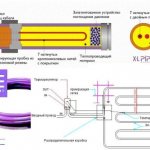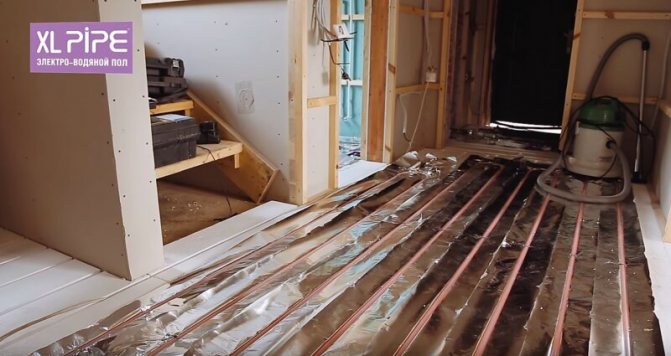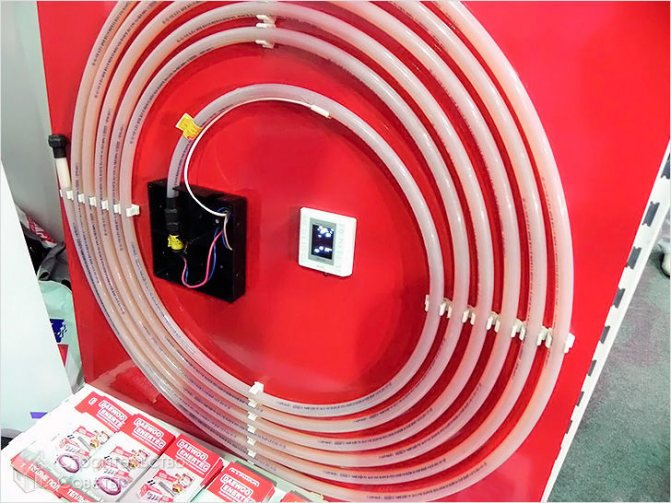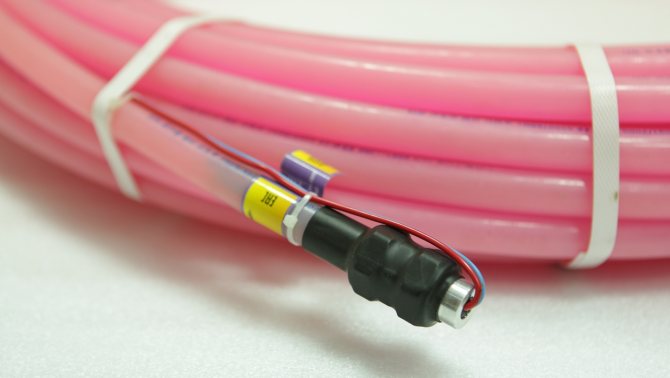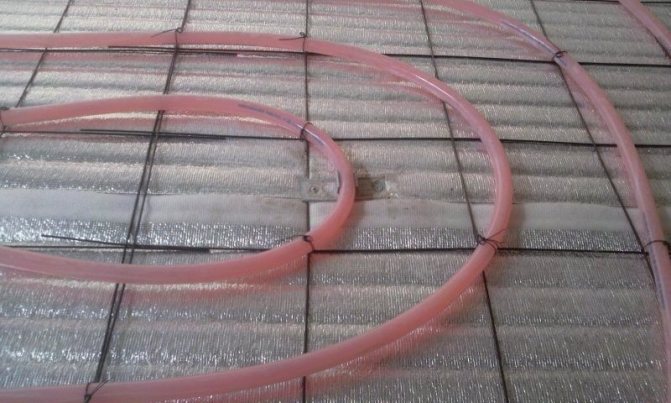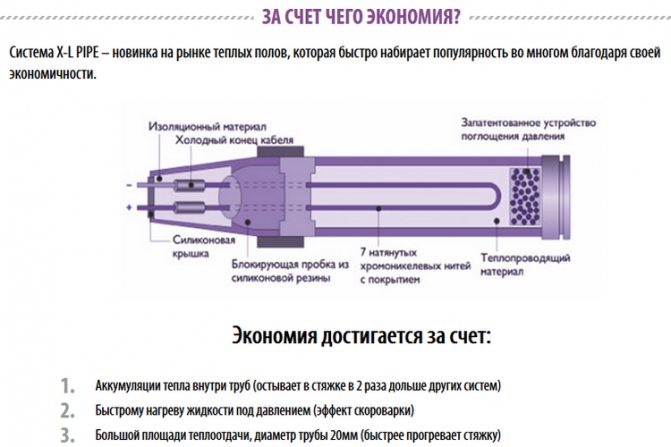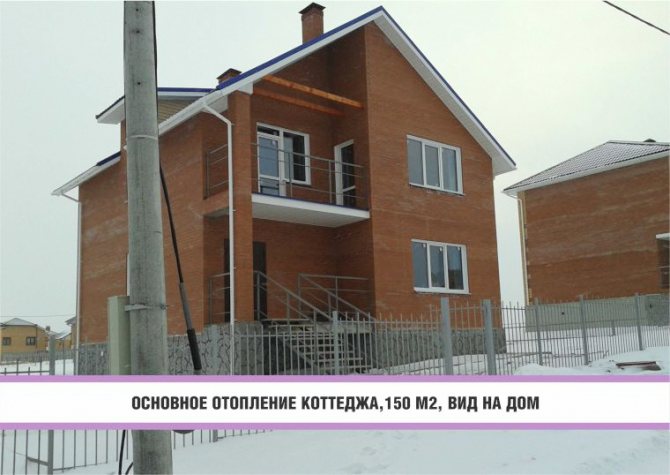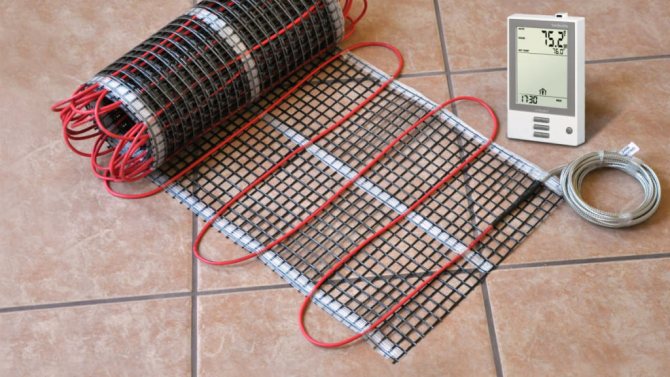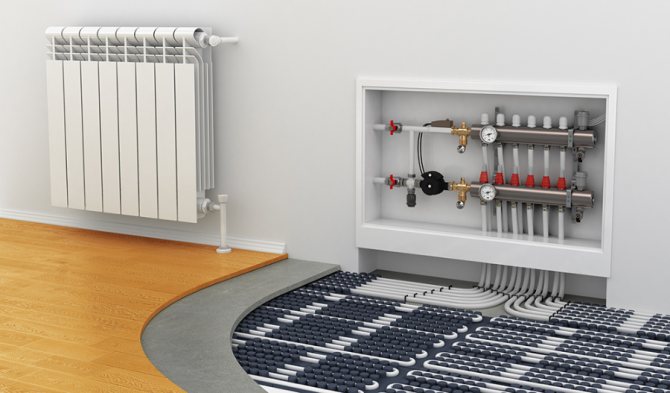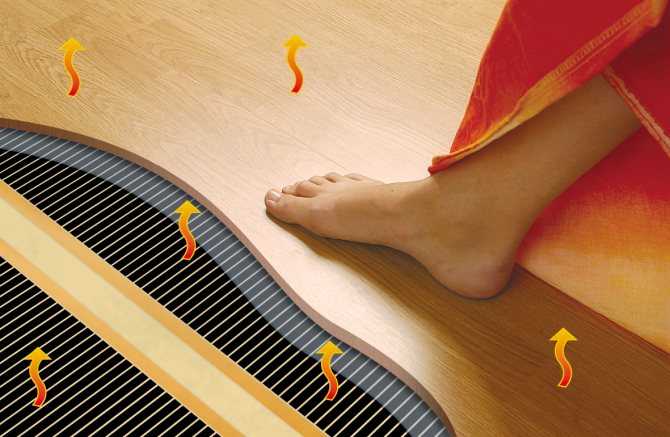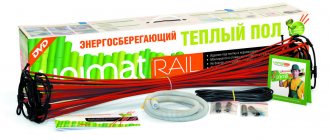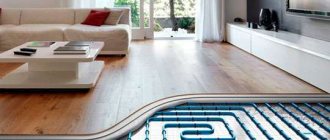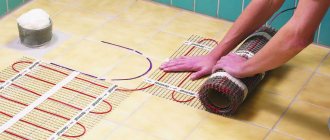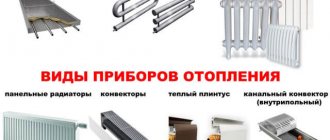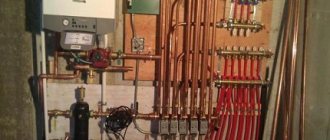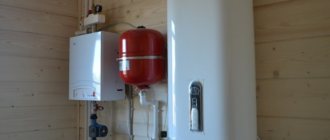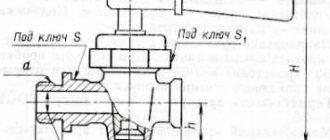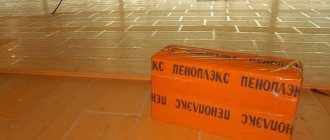When choosing the type of underfloor heating, you have to decide: install a water or electric underfloor heating. Electric is easier to install, but expensive to operate. You have to pay a little monthly for water, but its installation is complicated and very expensive (if you also install a boiler, a mixing unit, a collector). But today there is a symbiosis of both systems, which combines the advantages of both systems: a water (liquid) electric warm floor. By the way, this is the only option for a water-heated floor without a pump; in any other version, the system will be inoperative. There are two offers on the market today:
- From the Korean campaign Daewoo Enertec. Its product is called XL Pipe (X-L Pipe).
- Capillary floor UNIMAT AQUA from another Korean rather famous campaign Caleo, but it should be noted that products of the Russian branch of this campaign are sold in our country.
The systems are the same only in the fact that pipes filled with liquid are hidden in the screed, and that the heat carrier is heated from electricity. But the heating elements themselves and the method of heating the liquid are different. Read more about each of the systems below.
XL Pipe Liquid Electric Floor
The novelty of this system is in the structure of the heating element: structured polyethylene pipes (thick-walled with a diameter of 20 mm), filled with a heat carrier. A heating cable is inserted into the entire length. This is not an ordinary cable, but seven strands of chromium-nickel alloy with a Teflon sheath. Pipes with cable and heat carrier are hermetically sealed. The coolant is static and does not move, therefore, a pump is not needed in the system of water electric underfloor heating, as well as a boiler and a collector.
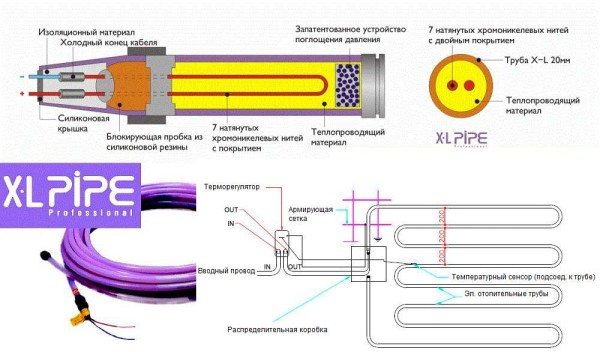
Underfloor heating XL Pipe (X-L Pipe) from the Korean campaign Daewoo Enertec - electric water heating
Antifreeze is used as a coolant, so it is more correct to call this system "liquid electric floor heating", but that is not the point. Everything should be installed in a screed: this way the heat spreads more evenly. It turns out that with this design, the main disadvantage of water heating has been eliminated: uneven heating, because the temperature of the liquid, and therefore the floor, is the same throughout the entire length. This option does not have a common "disease" of electric heating - an electric-water heated floor is not afraid of locking, that is, you can put and move furniture and large-sized equipment wherever you want.
Underfloor heating "DEU" can be used as the main heating or as simple floor heating to increase comfort: the heating power depends on the step of laying the heating pipes, which you choose yourself.
System composition and operating principle
As in any heating system, a thermostat (thermostat) with a floor temperature sensor is required to operate and maintain a stable temperature. They are installed in the same way as for conventional electric floors; a special thermostat is needed for this particular type of equipment.
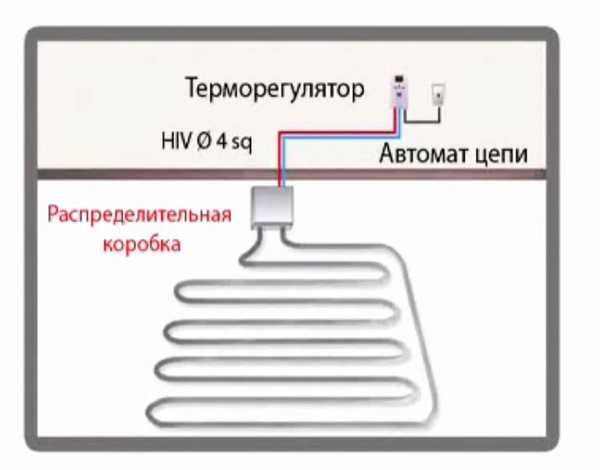

The XL Pipe system consists of an electric water heater and a thermostat with a temperature sensor
The principle of operation of XL Pipe is as follows: when the power is turned on, the heating cable heats the coolant (this is an antifreeze of a special composition). Heating occurs very quickly: the volume of the liquid is very small, and the heat output is decent. When a liquid is heated in a closed volume, an increased pressure arises, which contributes to a faster heating and an even distribution of heat (bubble boiling). Therefore, such a warm floor reaches operating temperatures much faster than usual.
The manufacturer of water-electric underfloor heating Daewoo Enertec guarantees the reliability, environmental friendliness and safety of its system. To absorb the excess pressure that occurs when the heat carrier is heated, a damping system has been developed and patented, which stabilizes the state of the heating element. Probably, you can trust them - the warranty period is 10 years, and the service life is declared 50 years. The difficulty is that while the system is new and reviews of the owners of this miracle could not be found.
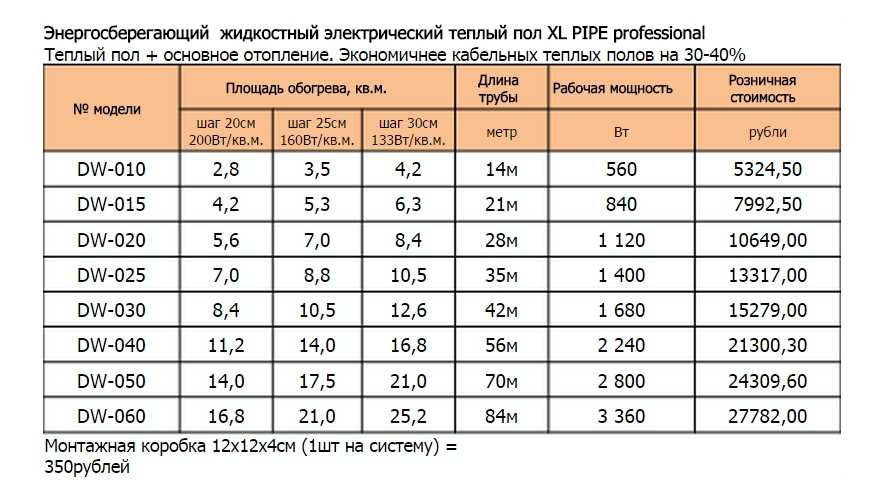

XL Pipe Specifications
But the best part is this: they say that the electric-water heat-insulated floor can be repaired. True, only service workers can carry out the work - special equipment is used. But what pleases me is that for repairs it is not necessary to break the entire screed as a whole, and it will take several hours to repair the damage. If the integrity of the cable is damaged, the leakage zone is easily determined: the liquid seeps out and a stain appears on the screed. At this point, you will need to break the screed. Then, having opened the junction box, carry out some manipulations using special equipment. The repair work itself is described in the video.
What is the profitability of XL Pipe
The system manufacturers claim that the system is more economical to operate than electric floors (20-30% less electricity bill), and less expensive to install than water floors (no need for a boiler, mixing and manifold units and a circulation pump).
Thus, the savings come in two parts:
- Less financial costs at the installation stage (in comparison with the installation of water heated floors).
- Less monthly heating costs (compared to electric heating).
Due to which the installation costs are lower - it is clear: you do not need a boiler, a mixing and manifold unit, a circulation pump. Requires an electric water pipe and a thermostat with a temperature sensor. But what about saving on heating needs to be explained: since the coolant does not move, it is heated very quickly. And no losses for heating the air at the mixing, manifold unit. All the heat goes to the floor heating. Therefore, the costs are less. In any case, this is what the manufacturers say.
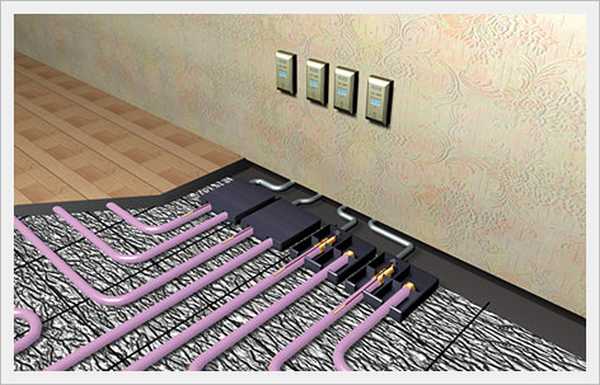

For large rooms, several circuits are used.
Installation of XL Pipe (X-L Pipe)
The entire installation sequence repeats the process of installing water systems to the smallest detail:
- Thermal insulation of the floor and perimeter of the room.
- Laying a heat-reflecting metallized layer.
- Installation of the fixing system (metal net or mounting fixing tape).
- Layout of the cable. Here the only difference is that the ends of the pipe need not be put on the manifold assembly, but into a special junction box located on the floor. Having sealed the ends of the wires with electrical tape, they are fixed in special grooves, the box cover is tightened with bolts and wrapped with waterproofing tape. After that, the wires from the junction box are brought to the thermostat (its installation principle is similar to the principles of installing the regulator for a conventional electric floor).
- Filling the screed.


How most XL Pipe systems are screed
As you can see, water electric underfloor heating in the installation practically does not differ in anything from a water heating device (with the exception of connecting a thermostat and electrical assembly of the system). After the screed is dry (28 days or less), you can lay the floor covering. You can see the installation sequence in the video clip.
Electric floors: pros and cons
Rooms with electric cables or heating mats in the floors are always warm and cozy. To obtain heat energy in this case, only electricity is needed. Electric floors are demanding on the premises: they must comply with the standards for the installation of electrical appliances, that is, dry.
If, with the water method of heating, the surfaces are heated unevenly, since they have time to cool down, plying through the pipes, then the electric ones are stable in this respect and give uniform heat over the entire area.
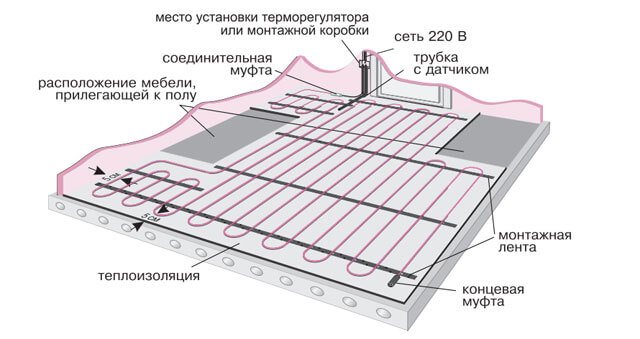

But there are also disadvantages of underfloor heating. Electric floors are not always convenient to use. Many factors need to be taken into account: what kind of finish will be in the room, how to arrange furniture. Before starting the installation of electric underfloor heating, a floor plan is drawn, which is then adhered to.
Electric floors are film and cable. The films are laid on a flat, clean sub-floor under the finish coat. Cable, by analogy with the water circuit, is poured with a concrete screed. By choosing any heating option, you can build underfloor heating in any house or apartment. There is a third way, where the advantages of a water and an electric floor are combined: these are liquid electric underfloor heating.
Capillary underfloor heating UNIMAT AQUA
These water-based electric underfloor heating has a different principle of operation. The main difference here is the diameter of the pipes: it is very small, hence the name - capillary. These tubes are connected to a small device that simultaneously heats the coolant, controls its temperature and creates pressure in the system (closed system).
Since the diameter of the pipes is small, there is a small amount of water in the system - up to 6 liters (necessarily distilled) and a small heater (no more than 2.4 kW) can handle its heating. Therefore, to install this version of the liquid-electric floor, the presence of a separate input is not required, although it is better to connect it through an RCD and an automatic device.
The maximum heating area is 20m2. Therefore, the system is not very suitable for large rooms, although several devices can be installed that work independently of each other. The warranty period is 5 years.
The composition of the capillary floor system and its capabilities
In order to assemble this type of heating, you will need at least two sets: basic and additional. The basic set of UNIMAT AQUA includes a complete control unit, two pieces of connecting pipe and a mounting kit (sleeves, tees and clamps), with which the pipeline is assembled and connected. An additional set is one or two coils of capillary tubes for different areas (from 10m2 to 20m2). In addition, for laying, you will need insulation, a damper tape, a heat-reflecting layer and fasteners for pipes, as well as a cement-sand mortar with a plasticizer for pouring the screed (or a special compound).


Basic set • capillary floor UNIMAT AQUA
The main advantage of this system is the sufficiently large functionality of the control unit. Here's what the capillary control unit can do:
- Maintain the anti-freeze mode (temperature + 15 ° C).
- Control either the state of the coolant or the room temperature of your choice.
- Maintain the power that you set yourself when starting the system (factory setting is 2.4 kW, and you can supply from 0.1 kW to 2.4 kW).
- The timer can be used to set the shutdown time of the system.
Installing UNIMAT AQUA
As for electric heating systems, everything needs to be started by choosing a place for installing the control unit. It is located on the wall, at a height of 1-1.2 meters from the floor level. The installation method is hinged, so there is no need to make holes. You need to securely attach the mounting plate, that's all. Please note that the device is plugged into an outlet, so choose a place near it.
Connecting pipes from the capillary floor will be supplied to the control unit and for their laying you will need grooves in the wall (or you can lay them in a plastic junction box fixed to the wall).


Installation diagram of capillary floors from Caleo (click on the picture to enlarge)
Installation of capillary tubes is standard: in a screed. There are no differences from the water heating device or from the method described above.The same requirements for the base (must be flat) and an excellent degree of thermal insulation is desirable. The "cake" and the installation sequence are the same. The scheme of laying in a screed is a double snake (see the picture), the laying step is 10-12 cm, the distance from the walls is 10-15 cm and more. After laying the heating pipes, they are connected using the components from the installation kit with the connecting ones (included in the basic kit). The connecting tubes are easy to distinguish - they have a square cross section. For greater maintainability of the system, it is advisable to place the docking place in a mounting box fixed to the floor. And from it, bring one-piece pipes to the control unit (in a gate or a mounting box not on a wall). There are special small pipes on the control unit, onto which the connecting pipes are pulled.
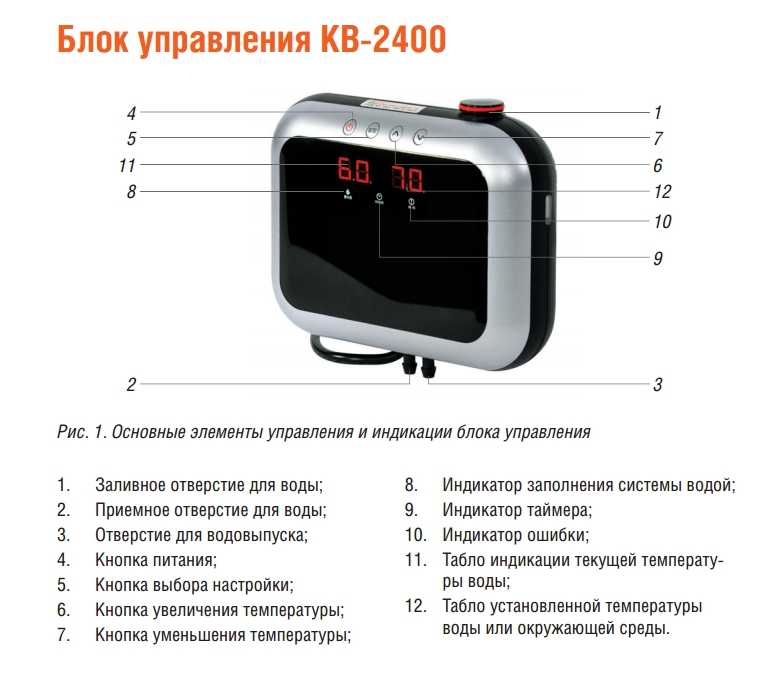

Control unit - heart and brain of the capillary system of the electro-water floor
The next step in the installation is to populate the system. Distilled water is poured into the inlet. Then the system is tested: the heating temperature is set on the control unit and the system starts to work. After checking, the heating is turned off, the water is not drained. When the coolant has cooled down (but not cold), the screed is poured. Its thickness is from 3cm to 5cm. It is possible to turn on the capillary system of the warm floor only after the screed has completely dried (at least 28 days).
Advantages and disadvantages of the capillary floor heating system
This version of the water-electric floor can only be used to increase comfort. It does not have enough power for the main heating. The advantage is the safety of the system (no electricity in the floor), which allows it to be installed in damp rooms (for example, in the washroom of a bathhouse) without any restrictions. On the other hand, to some extent, the disadvantages of water-heated floors remain: the water flows from the block is hotter, and therefore the floor warms up unevenly. The disadvantage is not so pronounced due to the recommended double snake when laying pipes, as well as due to the small volume of the system, which allows maintaining a small temperature difference between the supply and return pipelines.
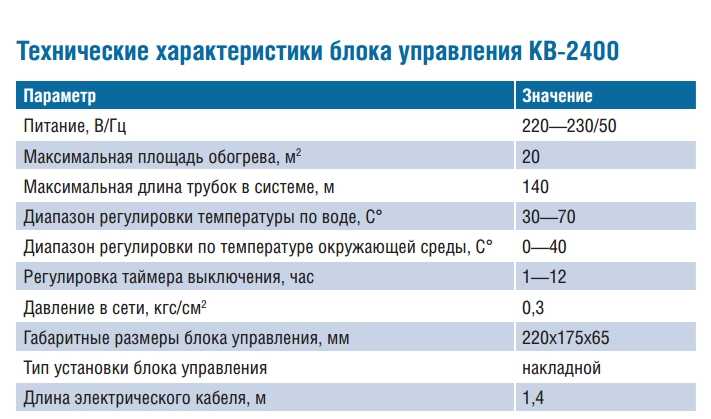

Technical data UNIMAT AQUA
There is no data on the maintainability of the system, although the main problematic unit - the joining of heating and connecting pipes - is recommended to be located in a separate accessible box, which provides for the possibility of repair. All other parts that may fail are located in the control unit, so repairs are possible.
XL Pipe: device and principle of operation
The floor heating xl pipe is arranged as follows. The reservoir for the coolant is a system of thick-walled polyethylene pipes with a diameter of 20 mm. The coolant in this case is antifreeze (of a certain brand). A seven-core electric cable made of chromium-nickel alloy, covered with a Teflon insulator, is laid in the tubes.
The pipe is hermetically sealed at both ends. That is, there is no need for the coolant to circulate. The whole system warms up very quickly and as evenly as possible.
The energy consumption of the xl pipe underfloor heating system is 14.5 watts / m2.


One of the advantages of XL Pipe is that furniture can be placed on top of the covering where they are mounted. Heavy objects will not bring harm, since the installation is carried out under a five centimeter cement screed.
The pipes are laid according to a special scheme. To regulate the temperature, a thermostat and a temperature sensor are installed. They are connected here in the same way as for other underfloor heating. However, a special thermostat is needed, which is suitable specifically for liquid underfloor heating.
The manufacturer gives a 10-year warranty for the operation of his product. However, if the installation is done correctly, then such a system will serve up to half a century.
Outcomes
Water electric underfloor heating is an interesting option in all aspects of underfloor heating.XL Pipe (X-L Pipe) seems to be more advantageous, but it also costs more, but it provides for the possibility of using it as the main heating (there is enough power with good insulation). If you just need a comfortable floor temperature in relatively small rooms, including those with high humidity, then the UNIMAT AQUA capillary underfloor heating looks more acceptable, although this is your choice.

